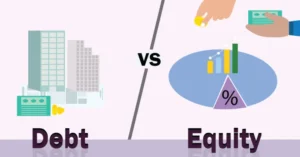Media & Events
Financing with Debt or Equity? For Businesses that Hold IP Rights its Essential to Differentiate
- Aug 11, 2025
Intellectual property rights are often perceived as a startup company’s most valuable assets — but how that value is realized can vary dramatically. It depends to a large extent on whether a company is raising capital through Debt or Equity funding — a loan with conditions or an ownership stake in the company.
While most early-stage entrepreneurs instinctively seek venture capital or angel investors (both, types of Equity funding), the role of Debt financing — especially when collateralized by IP — is often overlooked. These are strategic options which require serious consideration.
IP has different value propositions depending on the type of investor, the form of capital being deployed and the industry the IP functions in. For founders and investors alike, understanding these distinctions can mean the difference between scalable success and missed opportunity.
The differences are illustrated in the chart below, which lays out two dimensions of investment activity: Debt v. Equity, and Institutional (banks, VC funds) v. Strategic (corporate) investors. Each of the quadrants highlights the association that each type of investor has with the IP value of its underlying investment targets:
Equity Funding: Relying on the Growth Value of IP
Equity investors are shareholders, and as such, they are buying into future value and strategic growth. They care about how IP and IP rights support revenue growth, competitive market position, and long-term exits. Moreover, in Equity funding situations, IP needs to be strategically aligned with the company’s business model.
Software startups, for example, may rely less on patents and more on trade secrets, copyrights, and customer data early on, while biotech companies build robust patent portfolios to support licensing models from day one. Aligning your IP strategy with your go-to-market plan is essential. So is communicating it clearly to equity investors.
 Both Debt and Equity can be used for monetization or strategic advantage. Illustration: Foresight Valuation Group
Both Debt and Equity can be used for monetization or strategic advantage. Illustration: Foresight Valuation Group
Venture capitalists will often discount IP value if they perceive it as defensive-only or irrelevant to scaling. This makes it critical for entrepreneurs to educate investors not just on the existence of IP, but on how it contributes to “pivot value” (upper right quadrant) which represents growth opportunities into adjacent markets or new products, as well as exit potential.
For founders and investors alike, understanding Equity vs. Debt distinctions can mean the difference between scalable success and missed opportunity.
The “synergistic value” (lower right quadrant) is especially relevant in M&A situations, where strong IP positions can command premiums because they fill in gaps for acquirers or protect key competitive advantages. Strategic equity investors (corporate venture) are best suited to realize this value due to their connections to the parent corporation.
Liquidation Value Rules
In Debt funding situations, IP assets can be pledged as a collateral for a loan.  For IP-rich startups with positive cash flows, venture debt—a hybrid structure that combines a traditional equity raise with a loan—can provide additional growth capital without the extra dilution.
For IP-rich startups with positive cash flows, venture debt—a hybrid structure that combines a traditional equity raise with a loan—can provide additional growth capital without the extra dilution.
Venture lenders and other specialized financial institutions who lend against IP collateral are fundamentally focused on risk mitigation. Since loans are fixed income instruments, where the return is mostly limited to the interest on the loan, debt investors care less about the growth potential of your company and more about what those IP assets could worth if the company defaults on its loan. In other words, IP must have liquidation value (upper left quadrant) to be relevant to debt financing.
This means that patents, brands, and other IP assets used as a collateral need to be valued not by what they could earn in a thriving business, but by what they might fetch in a distressed sale. According to a paper published by the Harvard Law School, more than 40% of bankrupt companies sell at least one patent, and on average they sell 18% of their patent portfolios. In most liquidation situations, IP assets will typically be sold at a discount to fair market value.
In the not-so-common situations when the lender is a strategic investor, there could be a higher monetization value (lower left quadrant) when the lender takes over the IP collateral, as there may be synergies with the corporate lender’s own assets leading to more lucrative options than just a distressed sale.
Key Takeaways: IP Strategy Can Determine Funding Strategy
- In today’s dynamic funding environment, it is critical to understand how a startup’s IP value aligns with the type of capital it is pursuing.
- Whether raising debt or equity, your IP strategy should be tailored to what each type of investor values the most.
Ultimately, differentiating between debt and equity isn’t just a legal or financial technicality—it’s a foundational IP strategy decision.
- Debt capital providers want enforceable, transferrable, and independently valuable IP assets.
- Equity investors want strategically positioned assets that enhance growth and exit outcomes.
Image source: capitalsourcegroup.com; foresightvaluation.com

